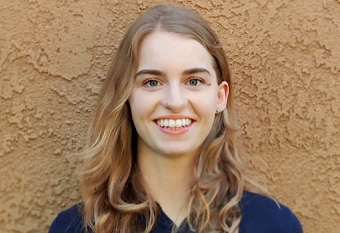
Chelsea Edwards, a third-year PhD student in UC Santa Barbara’s Chemical Engineering Department, won first place in the Materials Engineering and Sciences Division (MESD) Graduate Student Poster Competition during the American Institute of Chemical Engineers (AIChE) Annual Meeting. The premier educational forum for chemical engineers was held virtually this year due to the COVID-19 pandemic.
“I’m extremely honored. I think the poster competition provides a great opportunity to get the word out about my research,” said Edwards, who added that there were some advantages to a virtual poster presentation. “It’s still a very effective communication platform, especially combined with the online Q&A feature. We could embed videos, links, or pre-recorded narration, and space wasn’t limited like it would be on a static poster.”
Edwards, who earned her bachelor’s degree from MIT, is advised by Associate Professor Matt Helgeson. The primary research focus of the Helgeson Lab is to explore the formation and structure of colloids and gels and their response to external stimuli such as temperature, light, or shear flow, as well as to develop new tools for probing their multi-scale structure and dynamics. Colloids are complex fluid systems, typically either solutions of surfactant, polymer, or other nano- or micron-sized particulate in aqueous or oily solvent.
“Something like ninety percent of all manufactured chemicals exist as a colloid at some point either in their processing or as a product, which is why they are absolutely essential to chemical processing and technology,” said Edwards, who added that they also show up everywhere naturally in biological systems.
Edwards specializes in understanding the formation mechanism of polyelectrolyte complexes (PECs) and gaining predictability and control over their formation. PECs are aqueous, viscoelastic, polyelectrolyte-rich materials that grow from a colloidal solution of polyelectrolyte-rich droplets when charged polymers or proteins are mixed at the proper concentration with salt in water. Over the years, UCSB scientists have played a central role in PEC research after discovering that marine invertebrates, like mussels, exploit this process to produce water-resistant biological adhesives. Today, we know that PECs are common across formation of many structural biomaterials in nature.
“I really love working in this area because I think a better understanding of kinetics in these systems can both help our design of water-based polyelectrolyte materials and our understanding of how their naturally occurring counterparts function,” said Edwards. “Few people have asked questions about nonequilibrium in PECs, especially experimentally, so it’s nice to help push that cutting-edge. It’s exciting that there are so many open questions.”
Her award-winning presentation, “Processing Dependence and Aging of the Coacervate-Precipitate Transition in Mixed Polyelectrolytes,” sheds lights on the difference between two classes of PECs, coacervates and precipitates, which are often distinguished by microstructural roughness.
“It shows that colloidal and mass transport effects strongly influence the growth mechanism of PECs, which was unexpected and exciting because we were then also able to show that their nonequilibrium microstructure could be modulated using easily tunable external parameters like mixing flow rate,” Edwards explained. “It turns out that the microstructural precipitate-coacervate transition depends on processing, like mixing mechanics or aging, and not just chemistry or concentration of the components. And the assumption that a rough microstructure reflects a rheological transition isn’t always valid.”
Edwards, whose prior honors include a four-year National Defense Science and Engineering Graduate (NDSEG) Fellowship and first place in the American Physical Society’s Division of Polymer Physics Poster Session with Danielle Mai, now an assistant professor at Stanford, says this work is important because it could help scientists control formation and structure of polyelectrolyte complex materials, using universal handles beyond chemistry, polymer sequence design, and component concentration.



